As an aquarium enthusiast, I have always been fascinated by the Emperor Tetra. This beautiful fish is known for its vibrant colors and peaceful nature, making it a popular choice for both beginner and experienced fish keepers alike. However, caring for these fish requires a certain level of knowledge and expertise, especially when it comes to tank setup, water quality, tank mates, diet, common diseases, breeding, and more.
Emperor tetras require a well-maintained aquarium with suitable water conditions, a varied diet, and a peaceful environment. They need a pH range of 6.0-7.5 and a temperature range between 75-82°F. The aquarium should be planted, and regular water changes should be performed to ensure their health. They are peaceful and social fish, making them an excellent choice for community tanks.
In this article, I will share my personal experience and insights on how to care for Emperor Tetras. We will cover everything you need to know to keep these fish healthy and happy, from the ideal tank setup and water parameters to the best diet and tank mates. We will also discuss common diseases that can affect Emperor Tetras and how to prevent and treat them, as well as tips for breeding these beautiful fish successfully.
Whether you are a seasoned aquarist or just starting out, this article will provide you with valuable information and practical tips on how to care for Emperor Tetras. So, let’s dive in and explore the fascinating world of these stunning fish!
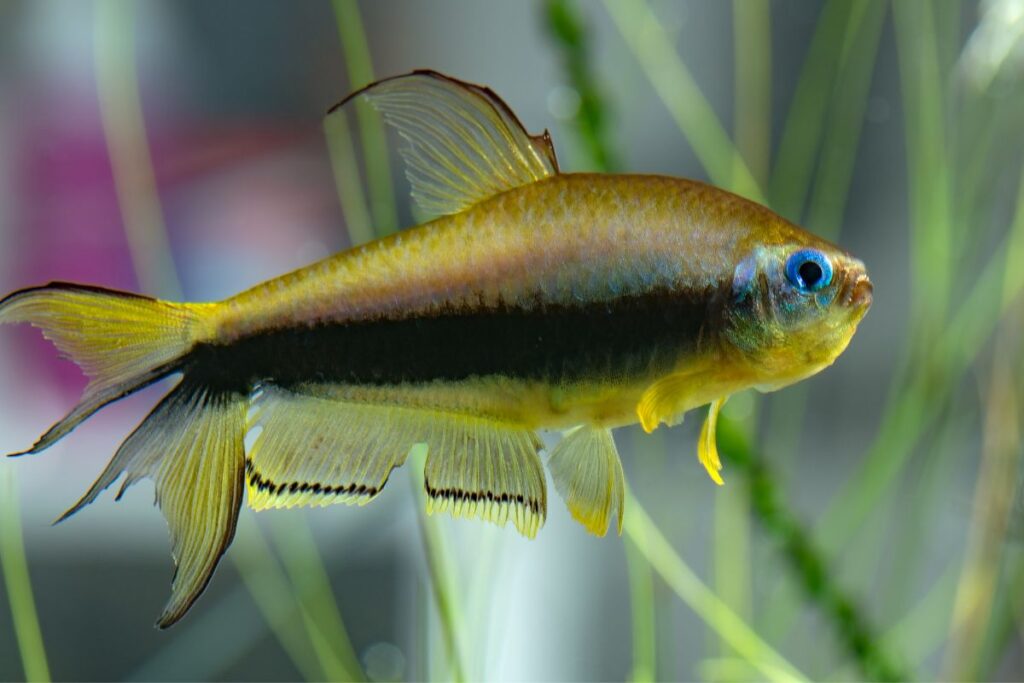
Table of Contents
Species Summary
Origin
Emperor Tetras are native to the Amazon basin in South America, specifically in Brazil, Peru, and Colombia. They can be found in slow-moving streams, tributaries, and flooded forests.
Lifespan
On average, Emperor Tetras can live up to 5 years in captivity with proper care.
Appearance
Emperor Tetras have a striking appearance with their bright blue and red colors. The blue coloration runs down the top half of their body, while the lower half is a vibrant red-orange. They also have a black stripe running from their eye to their tail.
Size
Emperor Tetras are a small species of fish, typically growing to around 1.5 inches in length.
Growth Rate
Emperor Tetras grow at a moderate rate, reaching their full size in around 6 months.
Behavior & Temperament
Emperor Tetras are a peaceful species that do well in community tanks with other non-aggressive fish. They are active swimmers and enjoy having plenty of space to explore.
Male vs Female
It can be difficult to distinguish between male and female Emperor Tetras. However, females tend to be slightly larger and rounder in the belly region, while males may have a slightly more elongated body shape.
I’ve found that Emperor Tetras make a great addition to any community tank. They are active and colorful, and their peaceful temperament makes them a joy to watch.
Tank Setup
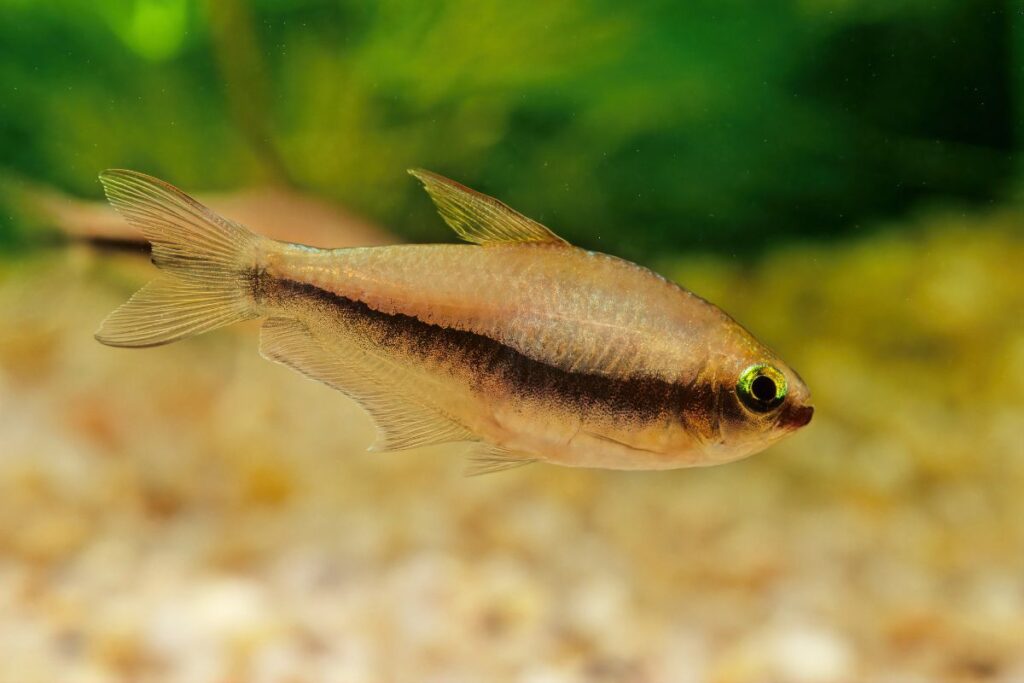
Tank Size
When it comes to Emperor Tetra care, one of the most important things to consider is the size of your tank.
As these fish are quite active and love to swim, it’s recommended that you provide them with a tank that’s at least 20 gallons in size. This will give them plenty of room to move around and explore their environment.
Lighting
Emperor Tetras prefer subdued lighting, so it’s best to avoid bright, direct light.
A low to moderate level of lighting will be ideal for these fish, and you can achieve this by using a simple aquarium light or by placing your tank in a location that doesn’t receive direct sunlight.
Filtration
Good filtration is essential for maintaining a healthy environment for your Emperor Tetras.
A good quality filter will help to remove any harmful toxins from the water and keep the water clean and clear. A hang-on-back filter or a canister filter are both good options for an Emperor Tetra tank.
Aeration
Aeration is also important for maintaining good water quality in your Emperor Tetra tank. Adding an air stone or bubbler will help to increase oxygen levels in the water and promote good health for your fish.
Heater
Emperor Tetras prefer a water temperature between 74 and 82 degrees Fahrenheit, so it’s important to have a good quality heater to maintain a consistent water temperature. A submersible heater is a good option for an Emperor Tetra tank.
Substrate
When it comes to substrate, Emperor Tetras prefer a soft, sandy substrate. This will mimic their natural environment and provide a comfortable place for them to rest and explore.
Plants and Decorations

Adding plants and decorations to your Emperor Tetra tank will not only make it look more attractive, but it will also provide hiding places for your fish.
Live plants are a great option, as they will help to maintain good water quality and provide a natural environment for your fish to thrive in.
Personally, I have found that adding a few small pieces of driftwood to my Emperor Tetra tank has made a big difference in their behavior.
They love to explore the wood and hide among the branches, and it has made them much more active and playful.
Water Quality
Ensuring the right water quality is crucial for the health of your Emperor Tetras. In this section, I will cover the key factors that you need to keep in mind when it comes to water quality.
Temperature
Emperor Tetras thrive in water that is between 75°F and 82°F. It is important to maintain a consistent temperature, as fluctuations can cause stress and make your fish more susceptible to diseases.
pH
The ideal pH range for Emperor Tetras is between 6.0 and 7.5. It is important to avoid sudden changes in pH levels, as this can cause stress and harm your fish.
Hardness
Emperor Tetras prefer soft to moderately hard water, with a hardness level of between 2 and 10 dKH. If your water is too hard, you may need to consider using a water softener or adding peat moss to your tank.
Ammonia and Nitrite
Ammonia and nitrite are toxic to fish and can cause serious health problems. You should test your water regularly to ensure that levels of these substances are at zero.
If they are not, you may need to perform a partial water change or use a water conditioner to neutralize them.
Nitrate
Nitrate is less toxic than ammonia and nitrite, but high levels can still be harmful to your fish. You should aim to keep nitrate levels below 20 ppm. Regular water changes can help to keep nitrate levels under control.
Water Changes
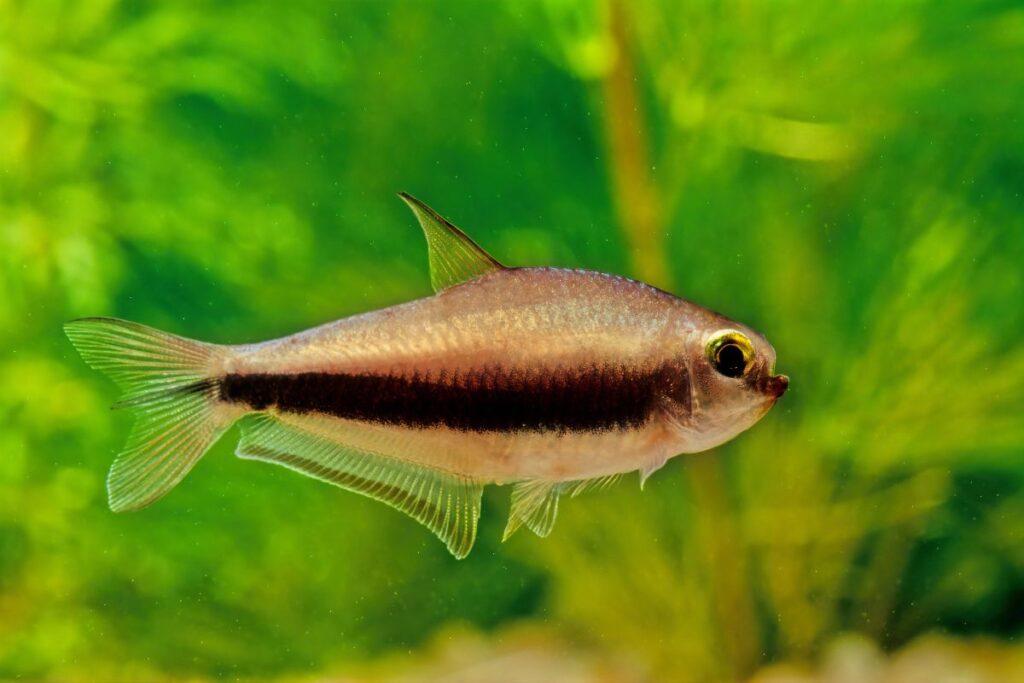
Regular water changes are essential for maintaining good water quality. Aim to change 10-20% of your tank water every week.
This will help to remove any accumulated toxins and keep your water clean and healthy.
By paying close attention to water quality, you can help to ensure that your Emperor Tetras thrive and stay healthy.
Tank Mates
As an aquarist who has kept Emperor Tetras, I know firsthand that choosing the right tank mates is essential for the well-being of these beautiful fish.
Here are some tips on compatible and incompatible tank mates for Emperor Tetras.
Suitable Tank Mates
Emperor Tetras are peaceful fish that do well in community tanks with other peaceful species. Some suitable tank mates for Emperor Tetras include:
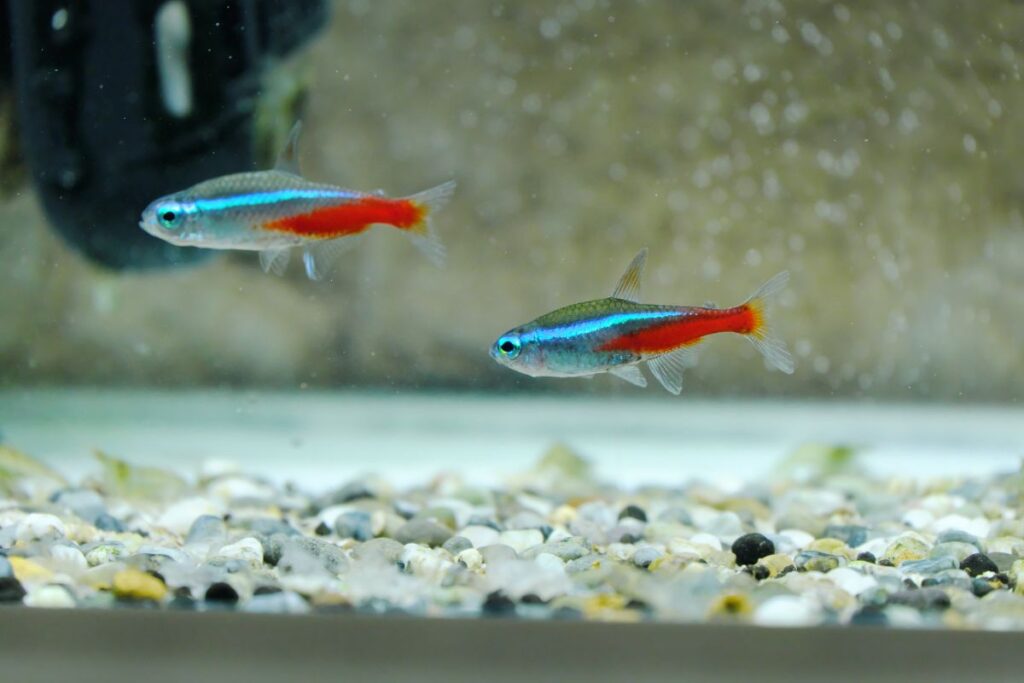
- Neon Tetras
- Cardinal Tetras
- Corydoras Catfish
- Otocinclus Catfish
- Small Rasboras
Incompatible Tank Mates
While Emperor Tetras are peaceful, they can be intimidated by larger, more aggressive fish. It is best to avoid keeping them with any fish that may bully or eat them. Some incompatible tank mates for Emperor Tetras include:
- Cichlids
- Angelfish
- Gouramis
- Betta Fish
- Large Catfish
In my experience, I have found that keeping Emperor Tetras with other small, peaceful fish creates a harmonious and visually stunning community tank. As always, it is important to research the specific needs and temperaments of any fish before adding them to your aquarium.
How Many Emperor Tetras Should I Have?
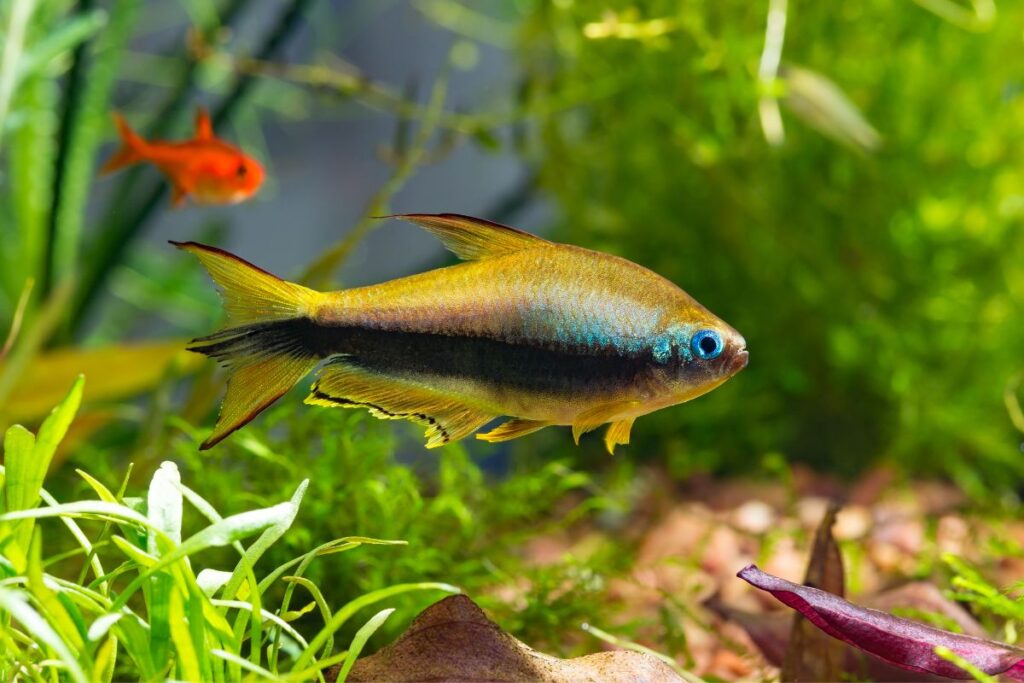
When it comes to stocking your aquarium with Emperor Tetras, the general rule of thumb is to have at least six to eight fish in a group.
This allows them to feel comfortable and secure in their environment, which can help reduce stress and improve overall health.
Personally, I have found that keeping a group of 10 to 12 Emperor Tetras in a 20-gallon tank provides a beautiful and lively display.
However, it’s important to remember that the number of fish you can keep in your tank will ultimately depend on its size and filtration capacity.
It’s also important to consider the other inhabitants of your tank when deciding how many Emperor Tetras to keep.
They are peaceful fish and do well with other small, non-aggressive species such as Corydoras, Otocinclus, and small Rasboras.
When introducing new fish to your tank, it’s important to do so gradually and monitor their behavior closely.
If any aggression or stress is observed, it may be necessary to adjust the number of fish in the group or consider rehoming certain individuals.
Diet
Proper nutrition is key to keeping your Emperor Tetras healthy and happy. In this section, I will discuss feeding frequency, types of food, and feeding techniques.
Feeding Frequency
I feed my Emperor Tetras twice a day, once in the morning and once in the evening. It’s important not to overfeed them, as this can lead to health problems and poor water quality.
Only give them as much food as they can eat in a couple of minutes.
Types of Food
Emperor Tetras are omnivores, meaning they eat both meat and plants.
I recommend feeding them a variety of foods, including flakes, pellets, frozen or live foods like brine shrimp, bloodworms, and daphnia. In addition, you can supplement their diet with vegetables like blanched spinach or zucchini.
It’s important to note that not all fish food is created equal. Look for high-quality brands that contain a good balance of protein, fat, and fiber.
Avoid foods that are high in fillers like wheat and soy, as these provide little nutritional value and can pollute the water.
Feeding Techniques
One technique I use to ensure my Emperor Tetras get a balanced diet is to rotate their food.
For example, one day I’ll feed them flakes, the next day pellets, and the following day frozen or live foods. This helps prevent them from becoming picky eaters and ensures they get all the nutrients they need.
You can also try using a feeding ring, which keeps the food in one spot and prevents it from sinking to the bottom of the tank. This makes it easier for your Tetras to find and eat the food, and also helps prevent overfeeding.
Finally, make sure to remove any uneaten food from the tank after a few minutes. This prevents the food from rotting and polluting the water, which can harm your fish.
Common Diseases

Diseases
I have been keeping Emperor Tetras for a while now, and I have learned that they are generally hardy fish. However, like any other fish, they are prone to some diseases.
Some of the common diseases that affect these fish include fin rot, ich, and dropsy.
Symptoms
When Emperor Tetras are sick, they may exhibit a variety of symptoms. For instance, if your fish has fin rot, you may notice that their fins are frayed or that they have white, stringy growths on them.
If your fish has ich, they may have white spots on their body or fins. Dropsy, on the other hand, causes the fish to become bloated and have pinecone-like scales.
Treatment
If you notice any of these symptoms, it is important to act quickly to prevent the disease from spreading to other fish in the tank.
The first step is to isolate the sick fish in a separate tank. You can then treat the fish using medication that is specifically designed to treat the disease. In addition to medication, there are some other things you can do to help your fish recover.
For instance, you can increase the water temperature slightly to speed up the healing process. You should also ensure that the water quality in the tank is good by performing regular water changes.
In conclusion, while Emperor Tetras are generally hardy fish, they are still prone to some diseases.
By keeping an eye out for symptoms and acting quickly, you can help your fish recover and prevent the disease from spreading to other fish in the tank.
Signs of a Healthy Emperor Tetra

As an experienced aquarist, I know that keeping fish healthy is crucial to their survival. When it comes to Emperor Tetras, there are several signs that indicate their good health. Here are some of the things I look for:
- Bright colors: A healthy Emperor Tetra will have vibrant colors that are well-defined and not faded.
- Active swimming: A healthy fish will be swimming around the tank with ease and vigor.
- Clear eyes: A healthy Emperor Tetra will have clear, bright eyes that are not clouded or bulging.
- Healthy fins: The fins of a healthy fish will be erect and not clamped to their body.
- Good appetite: A healthy Emperor Tetra will have a good appetite and will eagerly eat when food is offered.
It’s important to note that these signs are not foolproof, and it’s always a good idea to keep an eye out for any changes in behavior or appearance. If you notice any signs of illness or distress, it’s best to consult with a veterinarian or experienced aquarist.
Overall, maintaining the health of your Emperor Tetras is key to ensuring they live a long and happy life in your aquarium. By keeping an eye out for the signs of good health and providing them with a suitable environment, you can help your fish thrive.
Personally, I always feel a sense of pride and joy when I see my Emperor Tetras swimming around their tank in good health. It’s a testament to the care and attention I’ve given them, and it’s a reward in itself to see them thriving.
Signs of a Sick Emperor Tetra
As an aquarium owner, it is important to be able to recognize the signs of a sick fish. Here are some common signs to look out for if you suspect your Emperor Tetra may be ill:
- Loss of appetite: If your Emperor Tetra is not eating or appears to be losing weight, it could be a sign of illness.
- Unusual swimming behavior: If your fish is swimming erratically or struggling to swim, it could indicate a problem.
- Discoloration: If your Emperor Tetra is showing signs of discoloration, such as a pale or yellowish appearance, it could be a sign of illness.
- Clamped fins: If your fish’s fins are clamped against its body, it may be a sign of stress or illness.
- Gasping for air: If your Emperor Tetra is gasping for air at the surface of the water, it could indicate a problem with water quality or oxygen levels.
If you notice any of these signs, it is important to take action quickly to address the issue.
Some common diseases that can affect Emperor Tetras include fin rot, ich, and velvet. If you suspect your fish may be sick, it is important to quarantine it to prevent the spread of disease to other fish in the tank.
Personally, I have experienced a sick Emperor Tetra in my own aquarium. I noticed that the fish was not eating and appeared to be losing weight.
After doing some research, I discovered that it was likely suffering from a bacterial infection. I treated the fish with medication and it made a full recovery. It is important to be vigilant and take action quickly if you suspect your fish may be ill.
Breeding

Breeding Emperor Tetras can be a rewarding experience for aquarists. In this section, I will discuss the breeding setup, breeding process, and fry care.
Breeding Setup
To breed Emperor Tetras, a separate breeding tank is required. The breeding tank should be set up with soft, acidic water with a pH between 5.5 and 6.5.
The water temperature should be maintained between 78°F and 82°F. The breeding tank should be dimly lit to encourage spawning. A breeding mop or a spawning mesh can be used as a substrate for the fish to lay their eggs on.
The breeding tank should also be heavily planted with fine-leaved plants, such as Java moss, to provide hiding places for the fry.
Breeding Process
The breeding process of Emperor Tetras is relatively simple. Once the breeding tank is set up, introduce a group of healthy adult Emperor Tetras, with a ratio of one male to two females.
The fish will start to spawn in the early morning hours, laying their eggs on the substrate. The breeding process can last for several hours, and the fish can lay up to 100 eggs.
After spawning, the adult fish should be removed from the breeding tank to prevent them from eating the eggs. The eggs will hatch in about 24 to 36 hours, and the fry will become free-swimming in about five days.
Fry Care
Once the fry are free-swimming, they should be fed with infusoria or liquid fry food several times a day. After about a week, the fry can be fed newly hatched brine shrimp or crushed flakes.
It is important to maintain good water quality in the breeding tank, as the fry are sensitive to changes in water conditions.
The water temperature should be maintained between 78°F and 82°F, and the pH should be between 5.5 and 6.5. In conclusion, breeding Emperor Tetras can be a fun and rewarding experience for aquarists.
By providing a suitable breeding setup, following the breeding process, and providing proper fry care, you can successfully breed and raise Emperor Tetras in your aquarium.
Product recommendations for Emperor Tetras:
- TetraMin Plus Tropical Flakes: This high-quality fish food is specifically formulated for tropical fish like Emperor Tetras, providing a balanced diet that promotes health and vitality.
- Seachem Prime: This water conditioner is essential for maintaining a healthy aquatic environment for Emperor Tetras. It detoxifies ammonia, nitrite, and nitrate, and also provides essential electrolytes and vitamins.
- API Freshwater Master Test Kit: This comprehensive test kit allows you to monitor the water quality in your Emperor Tetra aquarium, ensuring that the pH, ammonia, nitrite, and nitrate levels are within safe ranges.
- Hikari Micro Pellets: Emperor Tetras love micro pellets, and these nutrient-rich pellets are a convenient and nutritious treat that can be fed as a supplement to their regular diet.
- Fluval Edge Aquarium Gravel Cleaner: This easy-to-use gravel cleaner makes maintaining your Emperor Tetra aquarium a breeze. It removes debris and waste from the substrate without disturbing your fish.
- Aqueon QuietFlow LED PRO Aquarium Power Filters: This high-performance filter is designed to keep your Emperor Tetra aquarium clean and healthy. It features a five-stage filtration system and LED lighting for added convenience.
- Marina Floating Thermometer with Suction Cup: This reliable thermometer ensures that the water temperature in your Emperor Tetra aquarium is within the ideal range. Its floating design makes it easy to read and adjust.
- Marina Fish Tank Scraper: This versatile tool allows you to clean the glass, remove algae, and scrape the substrate in your Emperor Tetra aquarium. Its ergonomic design makes it comfortable to use.
- Zoo Med Aquatic BettaMatic Automatic Daily Betta Feeder: This automatic fish feeder is perfect for busy fish owners who want to ensure that their Emperor Tetras are fed on a regular schedule. It dispenses food automatically and can be programmed to feed up to three times per day.
Conclusion
Overall, caring for Emperor Tetras can be a rewarding experience for any aquarist. These small, colorful fish are easy to care for and can add a lot of beauty to any aquarium.
When setting up their tank, it’s important to keep in mind the need for good water quality and a well-cycled tank. Providing plenty of hiding spots and plants can also help create a comfortable environment for these fish.
When it comes to tank mates, Emperor Tetras are generally peaceful and can be kept with other peaceful fish of similar size. However, it’s important to avoid keeping them with any aggressive or fin-nipping fish.
For their diet, Emperor Tetras are omnivores and will eat a variety of foods. A mix of high-quality flakes, frozen or live foods, and occasional treats can help keep them healthy and happy.
While they are generally hardy fish, it’s important to keep an eye out for common diseases such as fin rot and ich. Regular water changes and good tank maintenance can help prevent these issues.
Finally, if you’re interested in breeding Emperor Tetras, it’s important to provide them with a well-planted breeding tank and plenty of hiding spots. With the right conditions, these fish can breed easily and produce a large number of fry.
Overall, I have found caring for Emperor Tetras to be a fun and rewarding experience. These fish are a great addition to any community tank and can provide hours of enjoyment. I hope this guide has been helpful in providing you with the information you need to care for these beautiful fish!
Reference: Wikipedia.
